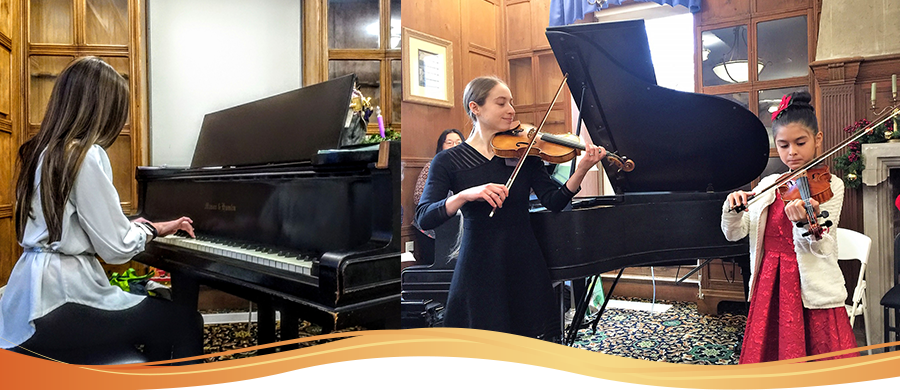
Online
Music for the Community
If you're interested in a particular category, you can sort performances by student age, instrument, singalong music, composer and so on - click on the orange tags under the text. We hope you and your family will enjoy watching our students share their music!
To have each week's videos and accompanying info sent to your inbox*, please subscribe via the orange button.
*Videos are delivered twice weekly; you can unsubscribe at any time, and we will never share or sell your info.
Subscribe to this Page
Displaying items by tag: Dance music
Day 56 - Handel Sarabande
Violinist age 14 plays "Sarabande" by Handel
It's probably no surprise that Georg Frederic Handel (1685-1759), an exact contemporary of Bach, also wrote many pieces featuring the dance forms that were popular among composers at the time. But it's hard to believe that the stately sarabande was originally thought to be a terrible influence - it was described in a "Treatise Against Public Amusements" in 1609 as "enough to excite bad emotions in even very decent people"!
The Sarabande probably had its origins in Central America, in particular Guatemala and Mexico, in the 16th century. It was actually banned in Spain by King Philip II in 1583, thanks to the sentiments above - but that didn't stop it being performed. It spread to Italy in the 17th century, and then - thanks to composers like Handel and Bach, who often used it in their suites of dances - to France, where it became a popular slow court dance.
Having started his career in his native Germany, in 1710 Handel became Kapellmeister (Music Director) at the court of Prince George of Hanover. But in 1714 Prince George became King George I of England, and Handel's success in England led him to settle there permanently. His famous "Water Music" suite was performed several times on barges on the River Thames for the King and his guests. In 1727 Handel was commissioned to write four anthems for the Coronation ceremony of the next king, George II, and one of these anthems, "Zadok the Priest", has been played at every British coronation ceremony since.
Day 46 - Hongroise (Hungarian Dance)
Violinist age 9 plays "Hongroise" by Robert Pracht.
Day 16: Gavotte from Bach's Orchestral Suite in D
Violist age 11 plays "Gavotte" from Orchestral Suite in D by Bach
Bach wrote four Orchestral Suites. They all have an opening piece called an Overture, followed by a collections of movements (individual pieces) based on the dance forms of the time. These suites were very popular in Bach's day, and could be considered the “easy listening” music of the mid-18th century.
This is the third movement of Bach's third suite of this type, written about 1730 and arranged here for viola. The term Gavotte for a lively dance originated in the 1690s from Provence in southern France. The Old Provençal word gavoto (mountaineer's dance) comes from gavot, a local name for an Alpine resident, which is said to mean literally "boor" or "glutton"! You can hear that this rather heavy-footed dance might well suit a country bumpkin....
Day 10: Tango by Neil Mackay
Violinist age 10 plays “Tango” by Neil Mackay
More dance music today – this time from South America. The tango combines musical elements from African, Native American and European cultures, and started in the 1880s among communities alongside the Rio de la Plata (Silver River), which is the natural border between the countries of Argentina and Uruguay. It was originally a dance for the common people, popular in dockside cafes and nightclubs, but eventually spread to Europe and North America too. Listen for the “Pa-PAH—pa pum-pum” rhythm that happens throughout the piece.
Day 9: Courante, Bach Suite #3 in C
Violist age 16 plays “Courante” from Bach Suite #3 for Viola/Cello
A viola is more than just a “big violin”. That extra size gives it a deeper, darker sound. Bigger things vibrate more slowly - try filling a smaller glass and a bigger glass with water, and tapping them each with a fork, and you’ll hear that idea at its most basic.
The viola has the same tuning as the cello, except an octave higher (meaning the viola’s strings vibrate exactly twice as fast as a cello’s) - so they can share some of the same music, including Bach’s solo suites. “Suite” means a collection of pieces which go together, and Bach’s suites are collections of 18th century dance music. “Courante” literally means “running”, and you can hear how this piece just keeps going and going – try running around to it!
If you like the sound of the viola, it’s a great instrument to learn to play – there are never enough viola players, and you will get lots of invitations to play with others!
Day 7: Minuet in C by Bach
Cellist age 11 plays Bach’s Minuet in C
A minuet is an elegant 18th century dance – think ladies in dresses with huge ruffled skirts, and gentlemen in knee britches. This dance in 3/4 time, with small, elegant steps and many bows and curtsies, was all the rage in the fancy ballrooms of Europe (especially France and England) from about 1650 to 1750. Since Bach lived from 1685-1750, this was basically the pop music of his time. See if you can feel the 1, 2, 3, 1, 2, 3 pulse, then get our your dress-up stuff and dance to the 18th century beat!


